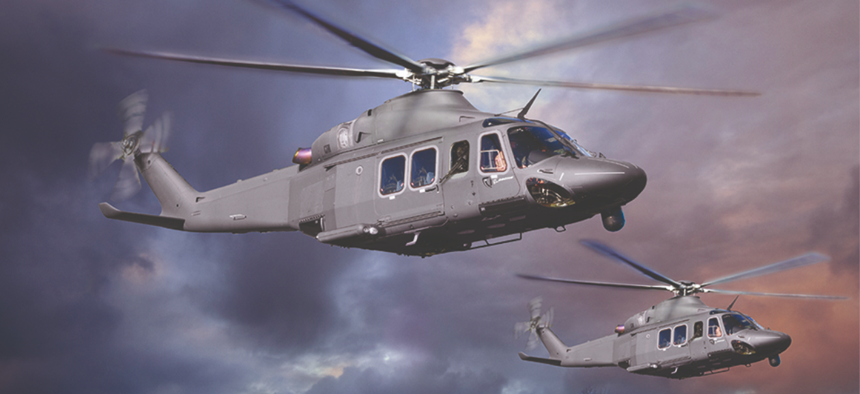
Boeing
An Italian-Designed, American-Built Helicopter Will Replace U.S. Air Force Hueys
The selection of the Boeing-Leonardo MH-139 ends a years-long quest to replace the 1970s-era UH-1Ns.
Almost two decades after the U.S. Air Force started trying to replace the Vietnam-era helicopters that patrol missile fields and stand by to evacuate senior officials, the service announced Monday that it has placed an initial order of MH-139 helicopters with the team of Boeing and Italian defense firm Leonardo.
Today’s contract awards $375 million for the first four MH-139s, the first batch of what is slated to be a $2.38 billion, 84-aircraft program. The deal is structured as a firm fixed-price contract, meaning that the company, not the government, would be on the hook for cost overruns.
Air Force officials said the program was initially estimated to cost $4.1 billion. "Strong competition drove down costs for the program, resulting in $1.7 billion in savings to the taxpayer,” Air Force Secretary Heather Wilson said in a statement.

The selection is an upset of Lockheed Martin’s Sikorsky, whose venerable Black Hawk was long considered the favorite. The MH-139 also beat out a bid by Sierra Nevada, which was proposing to acquire, overhaul, and update U.S. Army Black Hawks.
It’s a major win for Leonardo, which has been trying to expand its U.S. business led by former Deputy Defense Secretary William Lynn. Last year, Boeing teamed up with Leonardo — formerly Finmeccanica’s AgustaWestland — to pitch a militarized version of the latter’s commercial AW-139. The companies plan to build the helicopters at a Leonardo factory in northeast Philadelphia.
The new helicopters will guard intercontinental ballistic missile fields in North Dakota, Wyoming, and Montana. They will also stand ready to evacuate high-ranking government officials and members of Congress from Washington, D.C., in a national emergency. In all, the Air Force plans to buy 84 new helicopters.
The missile-field helicopters carry security teams over and around hundreds of ICBMs in underground silos. They also escort the armored convoys that carry the missiles between silos and military bases for maintenance. Commanders have been quick to point out that the Huey needs to land for refueling stops because it doesn’t have the range to traverse the expansive missile fields.
Calls to replace the Huey began after Sept. 11, 2001, when the U.S. military began beefing up security at its installations. The Air Force originally planned to buy a single helicopter type to replace its Hueys and its search-and-rescue HH-60G Pave Hawks, but soon split the project into two separate efforts. (The HH-60 replacement program was slowed by various problems between 2006 and 2009, slipped down the Air Force’s list of acquisition priorities, and culminated in a 2014 order of 114 Sikorsky CRH-60s.)
It took even longer for the Air Force to get back to the Huey replacement, which finally came front-burner after the aircraft struggled at a 2015 nuclear exercise, CQ reported. Initially, it looked as though Air Force leaders would hand the job to the H-60, but in 2016, they decided to hold a competition.
In August, Gen. John Hyten, who oversees the military’s nuclear weapons as head of U.S. Strategic Command, underscored the need for new helicopters.
"We are going to get a new helicopter in the missile fields," Hyten said. "We are going to get a new helicopter if I have to die trying or if I have to kill somebody to do it."
It’s rare for a European aircraft design to edge out an American one in a Pentagon competition, particularly for multibillion contracts. In 2006, the Army chose Airbus’ UH-72 Lakota as its Light Utility Helicopter, in part because it allowed the European firm to open a production facility for military and commercial helicopters in Mississippi.
As well, the U.S. Navy chose an AgustaWestland design for its new Marine One helicopter, but that contract was eventually cancelled.







